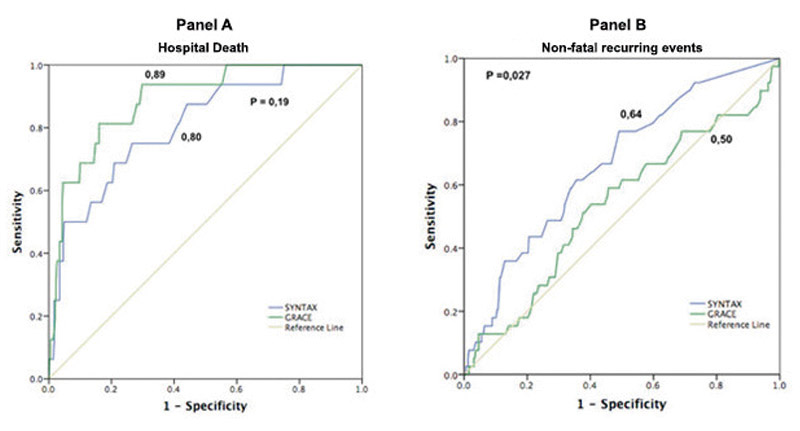Volume 115, Nº 2, August 2020
DOI: https://doi.org/10.36660/abc.20190062
ORIGINAL ARTICLE
Prognostic Contrast between Anatomical and Clinical Models Regarding Fatal and Non-Fatal Outcomes in Acute Coronary Syndromes
Mateus S. Viana
Vitor C. A. Correia
Felipe M. Ferreira
Yasmin F. Lacerda
Gabriela O. Bagano
Leticia L. Fonseca
Lara Q. Kertzman
Milton V. Melo
Marcia M. Noya-Rabelo
Luis C. L. Correia

Figure 1 – C-statistic of cardiovascular death prediction and non-fatal recurrent events, evidencing the accuracy of each score in relation to the type of outcome.
Abstract
Background: Recurrent ischemic events are mediated by atherosclerotic plaque instability, whereas death after na ischemic event results from gravity of insult and ability of the organism to adapt. The distinct nature of those types of events may respond for different prediction properties of clinical and anatomical information regarding type of outcome.
Objective: To identify prognostic properties of clinical and anatomical data in respect of fatal and non-fatal outcomes of patients hospitalized with acute coronary syndromes (ACS).
Methods: Patients consecutively admitted with ACS who underwent coronary angiography were recruited. The SYNTAX score was utilized as an anatomic model and the GRACE score as a clinical model. The predictive capacity of those scores was separately evaluated for prediction of non-fatal ischemic outcomes (infarction and refractory angina) and cardiovascular death during hospitalization. It was considered as significant a p-value <0,05.
Results: EAmong 365 people, cardiovascular death was observed in 4,4% and incidence of non-fatal ischemic outcomes in 11%. For cardiovascular death, SYNTAX and GRACE score presented similar C-statistic of 0,80 (95% IC: 0,70 – 0,92) and 0,89 (95% IC 0,81 – 0,96), respectively – p = 0,19. As for non-fatal ischemic outcomes, the SYNTAX score presented a moderate predictive value (C-statistic = 0,64; 95%IC 0,55 – 0,73), whereas the GRACE score did not presented association with this type of outcome (C-statistic = 0,50; 95%IC 0,40-0,61) – p = 0,027.
Conclusion: Clinical and anatomic models similarly predict cardiovascular death in ACS. However, recurrence of coronary instability is better predicted by anatomic variables than clinical data. (Arq Bras Cardiol. 2020; [online].ahead print, PP.0-0)
Keywords: Acute Coronary Syndrome/physiopathology; Atherosclerosis; Myocardial Infarction; Mortality; Cardiovascular Diseases/prevention and control; Hospitalization; Prognosis.















